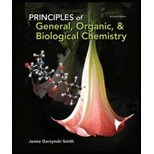
Concept explainers
a.
Interpretation:
IUPAC name for the compound A has to be given.
Concept Introduction:
IUPAC rules for naming
- Longest carbon chain is identified that contains the carboxyl group. Name of the parent
alkane is changed by replacing the “-e” by the suffix “-oic acid”. - Substituents present in the longest carbon chain is entered before the carboxylic acid name. If same substituents are present, then the respective Greek prefix is added before the substituents name.
- Locants are added and the substituents are entered in alphabetical order.
b.
Interpretation:
Isomer for the compound A has to be drawn that has same
c.
Interpretation:
Isomer for the compound A has to be drawn that has different functional group.
d.
Interpretation:
Product that is formed when compound A is treated with
Concept Introduction:
Water soluble salts are obtained as products when a carboxylic acid reacts with base such as sodium hydroxide. Carboxylic acid is converted into carboxylate ion by the transfer of proton to the base. On removal of proton from the carboxylic acid, the conjugate base is formed. Hydroxide ion from base and proton from the acid combines to form neutral water molecule.
e.
Interpretation:
The product that is formed when the compound A reacts with ethanol in presence of sulfuric acid has to be drawn.
Concept Introduction:
In presence of acid, the carboxylic acid and an alcohol reacts to form ester as product. Acid acts as a catalyst in this reaction. This is known as Fischer esterification reaction. Esterification reaction is an example of substitution reaction because, the
Want to see the full answer?
Check out a sample textbook solution
Chapter 13 Solutions
Principles of General Organic & Biological Chemistry
- presented by Morillon Leaning Predict the organic product for the min кусур HSC Adithane carved arnown to come than that to the condon slchroruis in acid in in aquishri with ноюarrow_forward6.15PM Sun Mar 30 K Draw the major product of this reaction. Include any relevant stereochemistry. Ignore inorganic byproducts. Problem 1 of O H [PhзPCH2CH3]*C|¯ NaH Drawing > Q Atoms, Bonds and Draw or tap a nearrow_forward8:17 PM Sun Mar 30 Draw the major product of this reaction. Ignore inorganic byproducts. HSCH2CH2CH2SH, BF3 Probler Drawing Ato Bonds Clarrow_forward
- Name the major organic product of the following action of 4-chloro-4-methyl-1-pentanol in neutral pollution 10+ Now the product. The product has a molecular formula f b. In a singly hain, the starting, material again converts into a secule with the molecular kormula CIO. but with comply Draw the major organic structure inhalationarrow_forwardMacmillan Learning Alcohols can be oxidized by chromic acid derivatives. One such reagent is pyridinium chlorochromate, (C,H,NH*)(CICTO3), commonly known as PCC. Draw the proposed (neutral) intermediate and the organic product in the oxidation of 1-butanol by PCC when carried out in an anhydrous solvent such as CH₂C₁₂. PCC Intermediate OH CH2Cl2 Draw the intermediate. Select Draw Templates More с H Cr о Product Draw the product. Erase Select Draw Templates More H о Erasearrow_forwardIf I have 1-bromopropene, to obtain compound A, I have to add NaOH and another compound. Indicate which compound that would be. A C6H5 CH3arrow_forward
- Provide the reagents for the following reactions.arrow_forwardIf I have 1-bromopropene, to obtain compound Z, I have to add two compounds A1 and A2. Indicate which compounds are needed. P(C6H5)3arrow_forwardDraw the major product of this reaction. Ignore inorganic byproducts. Assume that the water side product is continuously removed to drive the reaction toward products. O CH3CH2NH2, TSOH Select to Draw >arrow_forward
 Organic Chemistry: A Guided InquiryChemistryISBN:9780618974122Author:Andrei StraumanisPublisher:Cengage Learning
Organic Chemistry: A Guided InquiryChemistryISBN:9780618974122Author:Andrei StraumanisPublisher:Cengage Learning Organic ChemistryChemistryISBN:9781305580350Author:William H. Brown, Brent L. Iverson, Eric Anslyn, Christopher S. FootePublisher:Cengage Learning
Organic ChemistryChemistryISBN:9781305580350Author:William H. Brown, Brent L. Iverson, Eric Anslyn, Christopher S. FootePublisher:Cengage Learning Chemistry for Today: General, Organic, and Bioche...ChemistryISBN:9781305960060Author:Spencer L. Seager, Michael R. Slabaugh, Maren S. HansenPublisher:Cengage Learning
Chemistry for Today: General, Organic, and Bioche...ChemistryISBN:9781305960060Author:Spencer L. Seager, Michael R. Slabaugh, Maren S. HansenPublisher:Cengage Learning Chemistry: Principles and PracticeChemistryISBN:9780534420123Author:Daniel L. Reger, Scott R. Goode, David W. Ball, Edward MercerPublisher:Cengage Learning
Chemistry: Principles and PracticeChemistryISBN:9780534420123Author:Daniel L. Reger, Scott R. Goode, David W. Ball, Edward MercerPublisher:Cengage Learning



